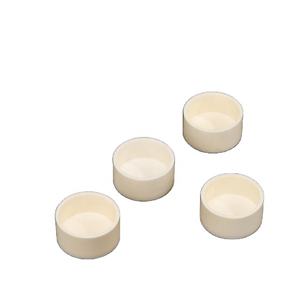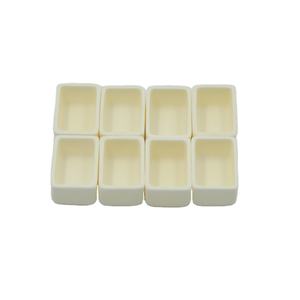Professional industry ceramic supplier, silicon nitride, silicon carbide, aluminum nitride and any other kinds of ceramics.
PRODUCT PARAMETERS
Description
Overview of Porcelain Glazed ceramic crucibles
Porcelain Glazed ceramic crucibles are specialized containers designed for withstanding extremely high temperatures in laboratory and industrial settings. They are essential for processes such as melting, calcining, and heat-treating a wide variety of materials, including metals, glasses, and chemicals. Our crucibles are engineered for superior thermal stability and chemical resistance, ensuring purity and reliability in the most demanding applications.
Features of Porcelain Glazed ceramic crucibles
-
Exceptional Thermal Shock Resistance: Withstands rapid temperature changes without cracking, ensuring durability and a long service life.
-
High-Temperature Stability: Maintains structural integrity at extreme temperatures, often exceeding 1500°C.
-
Excellent Chemical Inertness: Resists corrosion and reaction with molten metals, acids, and aggressive chemical fluxes.
-
High Purity & Low Contamination: Manufactured from premium materials to prevent sample contamination during sensitive processes.
-
Optimized Thermal Properties: Designed for efficient heat transfer and consistent performance in furnace environments.
-
Robust Mechanical Strength: Offers good resistance to physical impact and abrasion during handling and use.
Specifications of Porcelain Glazed ceramic crucibles
Porcelain glazed ceramic crucibles handle high heat in labs and industry. They are made from special ceramic materials. These crucibles get a smooth glassy coating. This glaze seals the surface. It stops chemicals from soaking into the ceramic. This makes cleaning much easier. The crucible stays cleaner for longer.
These crucibles resist very high temperatures well. They work fine up to 1200°C. Some types handle even higher heat. The glaze protects the ceramic underneath. It prevents cracking under sudden temperature changes. This is important for repeated heating and cooling cycles. The crucible stays strong.
Chemical resistance is a key benefit. The glaze fights off strong acids and bases. It works against corrosive salts too. This protects the ceramic body. It means the crucible lasts longer. It also means your samples stay pure. There is less chance of contamination. You get more reliable results.
Porcelain crucibles come in many sizes. You find small ones for tiny samples. Larger sizes hold more material. Common sizes are 10ml, 25ml, 50ml, 100ml. Bigger sizes exist too. Pick the size that fits your job. The shape is usually simple. It has straight sides and a flat bottom. This shape makes heating even. It also makes pouring easy.
The glaze makes the crucible non-porous. Liquids cannot leak through. This is crucial for melting things. It keeps everything contained. The smooth surface is simple to clean. You just wipe it out. A quick rinse often works. This saves time between uses. The crucible is durable. It resists chipping and scratching. It provides good value over time. Handle it carefully. Avoid sudden impacts. Store it properly.
Applications of Porcelain Glazed ceramic crucibles
Porcelain glazed ceramic crucibles handle tough heat jobs. Labs use them constantly. They heat materials to very high temperatures safely. Melting small metal samples is a common task. They work well for gold, silver, or aluminum bits. Preparing samples for analysis needs these crucibles. They hold the material steady while it gets super hot. Testing ash content in materials like coal or food uses them too. The glazed surface makes a big difference. Stuff doesn’t stick to it easily. This makes cleaning much simpler after use. Just rinse it out. No stubborn residue left behind. The glaze also creates a barrier. This stops chemicals from the crucible getting into your sample. Keeping your test pure matters. Contamination ruins results. The glaze fights chemical attack. Acids or bases won’t easily eat into it. Your experiment stays accurate. These crucibles withstand sudden temperature changes. Heating up fast or cooling down quickly won’t crack them usually. This durability saves money. You don’t replace them often. They last longer than unglazed types. Different sizes exist for different needs. Small ones suit tiny samples. Bigger ones handle more material. Remember the temperature limit. Check the specs for your crucible. Going too hot breaks them. They suit many industries. Universities, research labs, quality control labs, and jewelry makers rely on them. They are essential for precise high heat work. Handling them requires care. Use proper tongs. Let them cool slowly sometimes. Store them safely to avoid chips. Their reliability makes them a lab staple.
Company Profile
Tanki New Materials Co.Ltd. focus on the research and development, production and sales of ceramic products, serving the electronics, ceramics, chemical and other industries. Since its establishment in 2015, the company has been committed to providing customers with the best products and services, and has become a leader in the industry through continuous technological innovation and strict quality management.
Our products includes but not limited to Aerogel, Aluminum Nitride, Aluminum Oxide, Boron Carbide, Boron Nitride, Ceramic Crucible, Ceramic Fiber, Quartz Product, Refractory Material, Silicon Carbide, Silicon Nitride, ect. please feel free to contact us.

Payment Methods
T/T, Western Union, Paypal, Credit Card etc.
Shipment Methods
By air, by sea, by express, as customers request.
5 FAQs of Porcelain Glazed ceramic crucibles
Porcelain Glazed Ceramic Crucibles: 5 Common Questions
What temperature can these crucibles handle?
These crucibles withstand high heat. They typically work well up to 1200°C (2192°F). Exceeding this limit risks damage. Check the specific product rating before use. Always follow the manufacturer’s guidelines.
What materials can I melt inside them?
Glazed porcelain crucibles resist many chemicals. They work well for melting non-ferrous metals like gold or silver. They handle fluxes and some salts. Avoid materials containing lead or other heavy metals. These metals can damage the glaze. Avoid strong alkalis too. They attack the ceramic.
How do I clean a used crucible?
First, let the crucible cool completely. Never quench a hot crucible. Thermal shock breaks it. Remove large chunks of leftover material carefully. Use a non-metallic tool. For stubborn residue, soak the crucible in dilute acid. Vinegar or citric acid solution often works. Avoid harsh abrasives. They scratch the glaze. Rinse thoroughly with water. Dry completely before reuse.
Why does the glaze matter?
The glaze creates a smooth, glassy surface. This surface stops materials sticking to the crucible walls. It makes pouring melted material easier. It also seals the porous ceramic underneath. This seal stops chemicals soaking into the crucible body. It protects the crucible from corrosion. It makes cleaning much simpler.
Are these crucibles fragile?
Yes, ceramic crucibles break easily. Handle them with care. Avoid sudden temperature changes. Never heat a cold crucible too fast. Never cool a hot crucible too fast. Place them gently on surfaces. Don’t drop them. Don’t knock them hard. Use tongs designed for crucibles. Protect them from impacts.
REQUEST A QUOTE
RELATED PRODUCTS

Different-shaped Quartz Ceramic Metal Melting Crucibles, Presenting an Opaque and Milky White Appearance

High Chemical Stability Magnesium Oxide MgO Ceramic Crucible with High Purity 99.5%

Cylinder Zro2 Zirconia Ceramic Grinding Ball Mill Jar tank Crucible

Heat Resistant BN Boron Nitride Ceramic Crucible

Economical Glazed Ceramic/Porcelain Crucibles with Glazing Lids High Wall Ceramic Crucible



